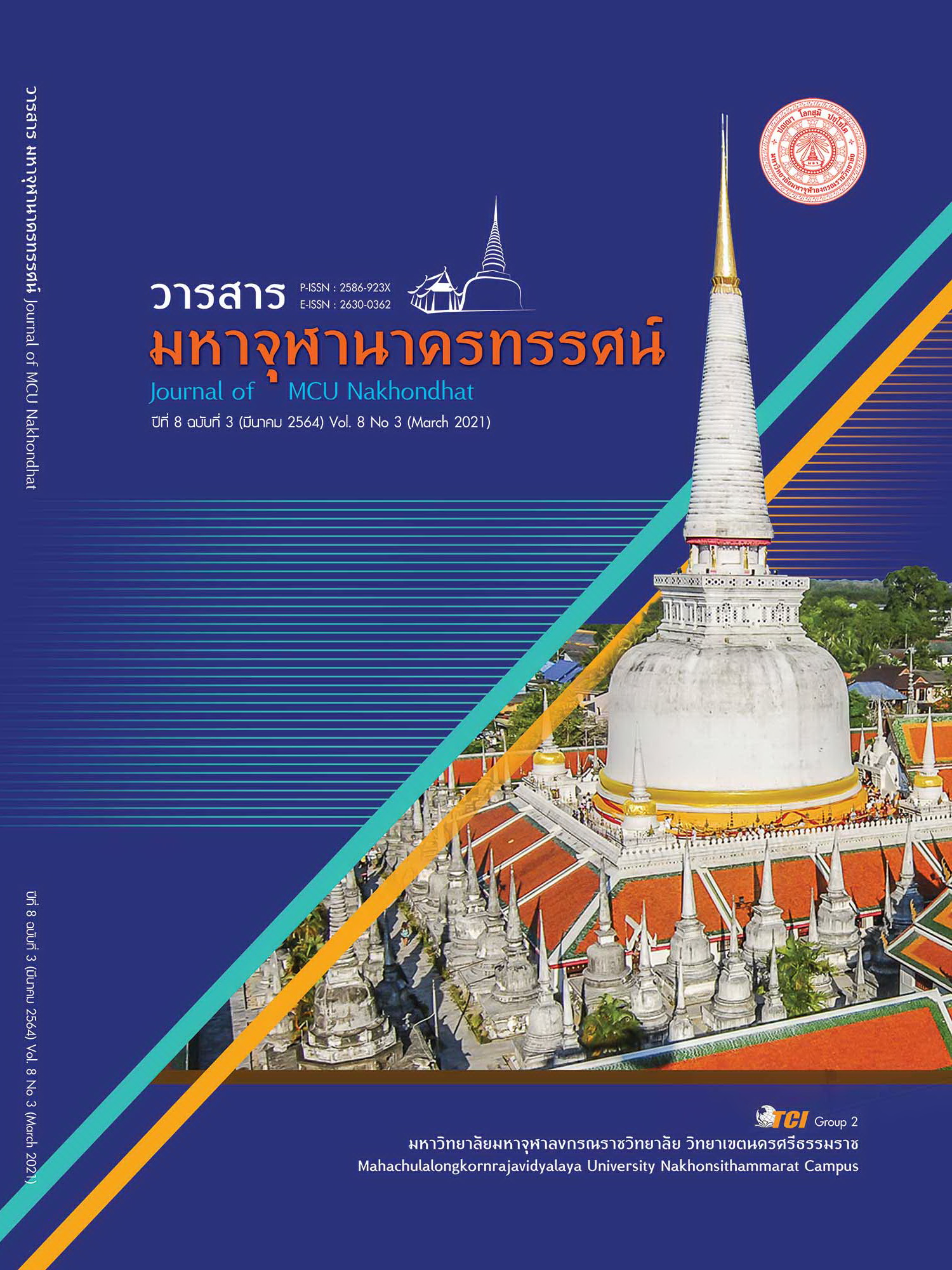CONSTRUCTIVE TECHNIQUES OF METAPHOR IN LITERARY OF SOMDET PHRA BUDDHA GHOSACARN (P.A.PAYUTTO)
Main Article Content
Abstract
The objectives of this research were 1) to study the Essence of Conceptual Metaphor in the literature of Somdet Phra Buddha Gosacarn (P.A.Payutto), and 2) to study formatting of metaphorical construction in the literature of Somdet Phra Buddha Gosacarn (P.A.Payutto). This research is a documentary research. The literatures of Somdet Phra Buddha Gosacarn (P.A.Payutto) written from 1988 to 2018 were used as the main data for analyzing. The data were analyzed to find out the formatting of the essence of conceptual metaphor and metaphorical construction according to the meaning of the nature in Dhamma in the concept of Buddha Dasa Bhikkhu. The results of the study were shown as following. In the literature of Somdet Phra Buddha Gosacarn (P.A.Payutto), there are 5types writing: 1) Notes from the seeing experience, 2) Notes from the journey and outdoor living, 3) Notes from various outlooks of Issues. 4) Notes from review, analysis and explanation about oneself, and 5) Notes from the issues of life, philosophy and spirituality. Then the study were found that: 1) The Essences of Conceptual Metaphor in the literature of Somdet Phra Buddha Gosacarn (P.A.Payutto) were found that there were two types: Lokiya Dhamma and Lokuttara Dhamma divided into 6 groups; 1) Similarity, 2) Difference, 3) Conflict 4), Conformity, 5) Reasonableness, and 6) so on. 2) The formatting of metaphorical construction in the literature of Somdet Phra Buddha Gosacarn (P.A.Payutto), according to the meaning of the nature in Dhamma in the concept of Buddha Dasa Bhikkhu were found that there were 4 types: 1) There were 38 Conceptual metaphors of nature, 2) there were 11 Conceptual metaphors of Law of nature, 3) there were 78 Conceptual metaphors of function of nature, and 4) there were 79 Conceptual metaphors of natural results.
Article Details
References
พระพรหมคุณาภรณ์ (ป.อ. ปยุตฺโต). (2555). พุทธธรรมฉบับขยาย. กรุงเทพมหานคร: มูลนิธิบรรจงสนิทและสำนักสหปฏิบัติ.
. (2556). กาลานุกรม: พระพุทธศาสนาในอารยธรรมโลก. (พิมพ์ครั้งที่ 6/2). กรุงเทพมหานคร: สำนักพิมพ์ผลิธัมม์.
พุทธทาส อินทปัญโญ. (2559). ธรรมะคือธรรมชาติใน 4 ความหมาย. เรียกใช้เมื่อ 25 ธันวาคม 2563 จาก https://www.youtube.com/watch?v=fJeXG5MWiWc
วิเชียร ชาบุตรบุณฑริก. (2535). พุทธศาสตร์. (พิมพ์ครั้งที่ 1). กรุงเทพมหานคร: สำนักพิมพ์โอเดียนสโตร์, พิมพ์ที่โอ.เอส.พริ้นติ้ง.
วุฒินันท์ แก้วจันทร์เกตุ. (2555). วิเคราะห์ถ้อยคำอุปลักษณ์เกี่ยวกับกิเลสในภาษาไทย. กรุงเทพมหานคร: คณะมนุษยศาสตร์ มหาวิทยาลัยธรรมศาสตร์.
ศรีวรา ผาสุกดี. (2558). อุปลักษณ์เชิงมโนทัศน์ในชีวิตตามภาษารัชเชีย. กรุงเทพมหานคร: มหาวิทยาลัยรามคำแหง.
เสถียร โพธินันนทะ. (2543). ประวัติศาสตร์พุทธศาสนา. (พิมพ์ครั้งที่ 4). นครปฐม: โรงพิมพ์มหามกุฏราชวิทยาลัย.
หลวงวิจิตรวาทการ. (2562). ประวัติศาสตร์เอเชีย. กรุงเทพมหานคร: สำนักพิมพ์แสงดาว.
อุษา พฤฒิชัยวบูลย์. (2544). การศึกษาอุปลักษณ์เรื่องการเมืองในภาษาไทยตามแนวอรรถศาสตร์ปริชาน. ใน วิทยานิพนธ์ศิลปศาสตร์มหาบัณฑิต. สาขาวิชาภาษาศาสตร์ มหาวิทยาลัยธรรมศาสตร์.
Sir, E. A. (1996). The Life of Asia. New Delhi: Intellectual Publishing house.
Lakoff, G. & Johnson, M. (1980). Metaphors we live by. Chicago: The University of Chicago Press.


